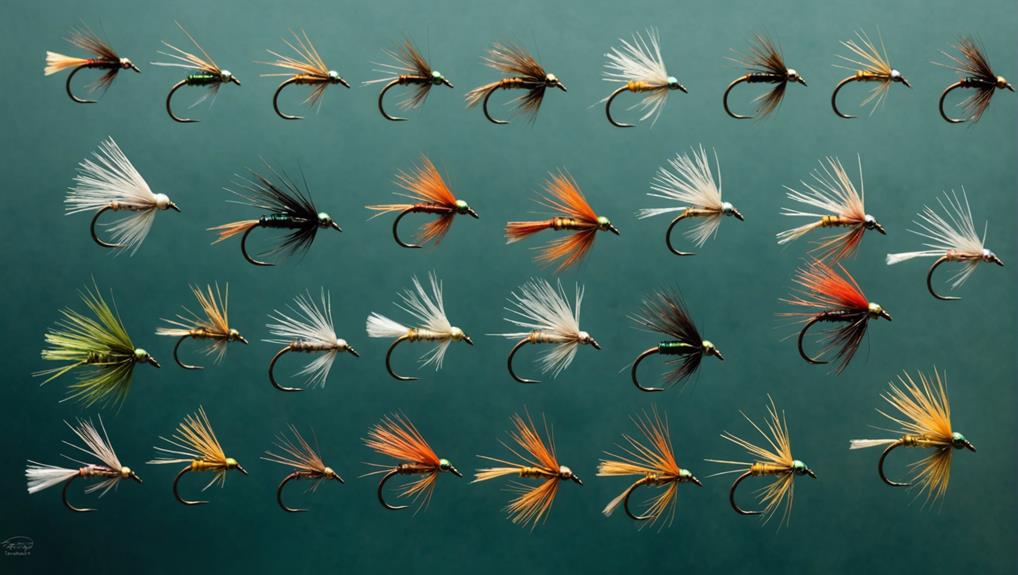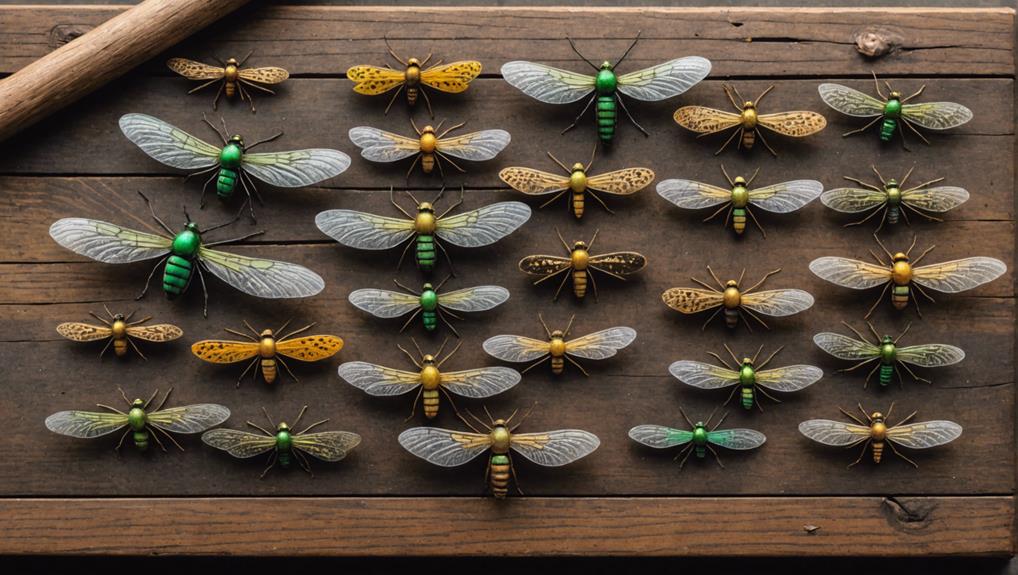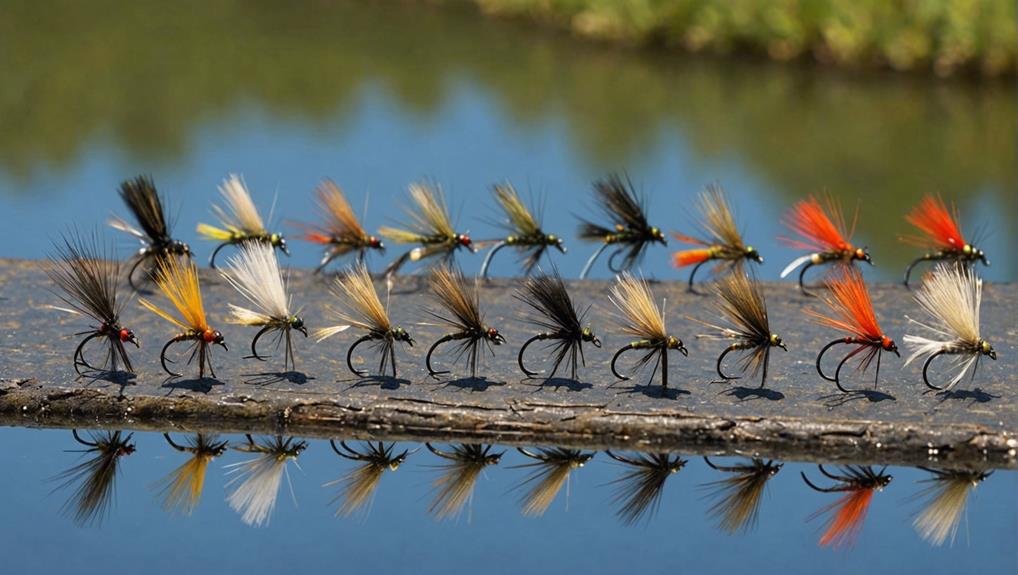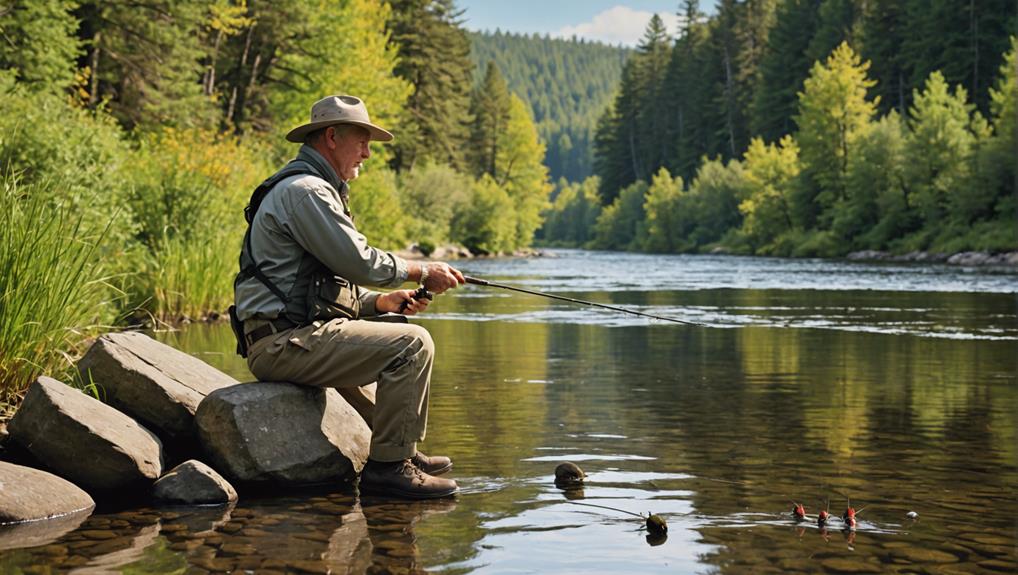In September, you’ll find success fishing for trout by equipping your fly box with diverse and effective patterns. Start with the Parachute Adams and Elk Hair Caddis for dry fly action. Don’t overlook nymphs like the Pheasant Tail and Beadhead, which consistently perform well. Blue-Winged Olives are crucial for emerger situations, while Woolly Buggers make excellent streamers. Incorporate Caddis imitations, especially during late hatches. For larger targets, add terrestrials like Chernobyl Ants to your arsenal. Always make sure your selection matches the local hatch conditions to increase your chances. There’s much more to explore to enhance your September trout outings.
Key Takeaways
- Include Blue-Winged Olive patterns, as they are effective during September mayfly hatches.
- Use Terrestrial patterns like Chernobyl Ants and Hopper patterns, ideal for late summer and early fall.
- Stock up on Caddis imitations such as Elk Hair Caddis for evening fishing when caddis are active.
- Incorporate Streamers like Woolly Buggers to mimic baitfish and trigger aggressive trout responses.
- Add Nymphs like Pheasant Tail and Copper John, essential for subsurface feeding trout.
Selecting Effective Dry Flies
When targeting rising trout in September, selecting the right dry flies, such as Parachute Adams, Elk Hair Caddis, and Blue-Winged Olive, is essential for mimicking the natural insect hatches effectively. You’ll want to focus on the size, color, and pattern of these flies to closely match the local insect activity.
Dry fly sizes vary, but choosing the correct size is vital. If you’re seeing smaller mayflies, size 18 to 22 may be ideal. For larger caddisflies, sizes 14 to 16 might be more effective. Colors should also reflect what’s hatching; olives and grays are perfect for mayflies, while tans and browns work well for caddisflies.
Mastering matching the hatch techniques will enhance your fishing success. This involves observing the insects on the water and selecting a fly that not only looks similar but behaves similarly. Pay attention to how the natural insects sit on the water and how they move. Your fly should mimic this as closely as possible to convince wary trout. A drag-free drift is also paramount, ensuring your fly floats naturally with the current, just like the real insects. By perfecting these aspects, you’ll significantly increase your chances of enticing a strike.
Essential Nymph Patterns
While dry flies effectively mimic surface insects, sub-surface nymph patterns like Pheasant Tail and Hare’s Ear prove essential for reaching trout feeding deeper in September. As trout shift their feeding habits to deeper waters, incorporating nymphs that imitate mayflies and caddisflies can significantly increase your success.
Understanding nymph size selection and exploring color variations are vital. Smaller nymphs often yield better results as they resemble the size of natural prey in this season. Experiment with different hues to match the local aquatic life—subtle changes can be surprisingly effective.
Weighted nymphs offer significant advantages, ensuring your fly reaches the feeding zone quickly and maintains a presence where trout are most active. Mastering presentation techniques such as the dead drift or slight twitch can mimic natural movements, enticing trout to strike.
Here’s a quick guide to help you choose effectively:
| Nymph Pattern | Size Range | Common Colors |
|---|---|---|
| Pheasant Tail | #12-#20 | Natural, Olive |
| Hare’s Ear | #10-#16 | Tan, Gray |
| Prince Nymph | #12-#18 | Black, Purple |
| Copper John | #12-#20 | Red, Green |
| Beadhead | #14-#18 | Gold, Silver |
Best Emerger Varieties

In September, you’ll find that emergers are essential for successful trout fishing, particularly when targeting selective feeders. Choosing the right emerger patterns, such as the CDC Baetis Dun or the versatile Parachute Adams, can greatly increase your catch rates.
Pay attention to water conditions and insect activity to select the best emerger for the situation, enhancing your strategy for enticing those elusive trout.
Popular Emerger Patterns
Among the most effective emerger patterns are the CDC Baetis Dun, Parachute Adams, and Blue-Winged Olive, each designed to mimic the vulnerable stage of insects evolving to adulthood just below the water’s surface. When you’re on the water, employing these emerger patterns can greatly enhance your catch rate. Focus on emergers during hatches, as trout often key in on these forms. As for emerger fishing strategies, make sure your fly drifts naturally with the current, mimicking an emerging insect. This realistic presentation is crucial for enticing wary trout.
For tying your own, mastering emerger fly tying techniques is essential. Pay attention to the size and color to match local insect populations. Accurate imitation enhances effectiveness, making your fly irresistible to trout.
Emerger Selection Tips
Selecting the appropriate emerger pattern is essential for successful trout fishing in September, as each variety offers unique advantages to match local hatches and conditions. When considering emerger presentation techniques and fly tying materials, focus on patterns that mimic the life stages and behaviors of local insects.
| Emerger Pattern | Key Material | Ideal Condition |
|---|---|---|
| CDC Baetis Emerger | CDC Feathers | Clear, slow-moving water |
| Sparkle Dun Emerger | Synthetic Fibers | Bright, sunny days |
| Quill Gordon Emerger | Stripped Peacock Quill | Cloudy, cooler days |
| Comparadun Emerger | Deer Hair | Low light conditions |
| RS2 Emerger | Microfibetts | Varied water types |
Each pattern and material is designed to enhance the realism and effectiveness of your fly, optimizing your chances of attracting selective trout.
Top Streamer Choices
As you explore the top streamer choices for September trout fishing, understanding the right color selection and retrieval techniques is important.
You’ll find that varying the colors of your streamers such as Woolly Buggers or Circus Peanuts can greatly impact their visibility and attractiveness to trout.
Additionally, mastering different retrieval methods, whether it’s a slow strip or a vigorous twitch, can provoke more aggressive strikes from your target fish.
Streamer Color Selection
When choosing streamer colors for trout fishing in September, consider how different hues can either mimic natural prey or provoke aggressive strikes, depending on water clarity and light conditions. Color psychology plays a significant role in this selection process. Natural colors like olive, brown, and black seamlessly blend into the environment, effectively imitating the baitfish that trout typically hunt, aligning with their instinctual behaviors.
On the other hand, in murkier waters or during low light conditions, brighter colors such as white, chartreuse, and orange stand out, triggering a more aggressive response from trout. This reaction is rooted in fish behavior, where distinct colors can stimulate an assertive predatory action. Don’t hesitate to experiment with various shades to discover what resonates best with the trout under your specific fishing conditions.
Retrieval Techniques Explained
To effectively entice trout in September, you should master various streamer retrieval techniques such as stripping, swinging, and twitching, each designed to mimic the erratic movements of fleeing prey. Stripping involves quick, sharp pulls to make your streamer dart through the water, simulating a wounded baitfish. Swinging lets your fly move across the current, appealing to trout’s instinct to ambush. Twitching adds sudden, sporadic movement, provoking aggressive strikes.
Understanding trout behavior this season is important. As water temperatures drop, trout become more active and aggressive. Selecting the right streamer, like a Woolly Bugger or a Zonker, and pairing it with effective streamer presentation can greatly increase your success. Vary speed and depth to match the trout’s activity level and watch your catch rate soar.
Effective Caddis Imitations

Understanding the behavior and life cycle of caddisflies can greatly enhance your success with Elk Hair Caddis and X-Caddis imitations. You’ll find that these insects undergo a change from larva to pupa to adult, each stage offering a significant opportunity for imitation. Focusing on caddis behavior insights and fly selection tips will guide you in choosing the right moment and pattern for your fishing.
When caddisflies are actively hatching, trout feeding habits shift to focus on these easy meals. Observing whether trout are taking insects on the surface or below can dictate whether you opt for an Elk Hair Caddis or a subsurface larval imitation. Here’s a breakdown of effective caddis imitations:
| Stage | Fly Pattern | Best Conditions |
|---|---|---|
| Larva | Caddis Larva | Clear, slow water |
| Pupa | Sparkle Pupa | Pre-hatch |
| Emerging | X-Caddis | Slightly choppy water |
| Adult | Elk Hair Caddis | Dry fly fishing |
| Spent | Spent Caddis | Evening or dusk |
These patterns are essential as they imitate the natural lifecycle changes that caddisflies undergo. Implementing imitation fly tactics can be the difference between a good day and a great day on the water. Always be ready to adapt your approach based on what the trout are telling you with their behavior.
Key Mayfly Replicas
While caddis imitations play a key role in your fly fishing arsenal, don’t overlook the effectiveness of mayfly replicas like the Parachute Adams during September. Understanding the mayfly lifecycle is essential to selecting the right fly at the right time. Early in the month, focus on using patterns that mimic the younger nymph stages, such as the CDC Baetis Dun. This fly’s realistic appearance taps into the trout’s instinctual feeding habits, as they’re used to seeing these insects evolve and progress through their lifecycle.
As the month progresses and temperatures begin to drop, adult mayflies such as the Blue Winged Olive become more prevalent. This pattern is particularly effective for fooling selective trout, which are known to feed aggressively on these adults, especially during overcast days when mayflies are most active. The Griffith’s Gnat is another indispensable choice for replicating clusters of mayflies on the water’s surface, an irresistible sight for feeding trout.
Essential Midges for Success

Frequently, midges serve as a critical food source for trout in September, so incorporating imitations like the vibrant CDC Midge Pupa into your fly selection is essential for success. This red-hued fly mimics the natural larvae effectively, making it a standout choice during tricky midge hatches.
To optimize your success, focus on midge presentation techniques. When fishing midges in stillwater, delicate casts and minimal disturbance are crucial. The slow sinking nature of the Crystal Midge fly offers a realistic presentation, mirroring the natural midge larvae suspended in water. This technique proves particularly effective in pressured waters, where trout are wary and selective.
Timing is also critical. Midge hatch timing can vary, but early morning or just before dusk are prime times when midges are most active. During these periods, trout are more likely to feed on the surface, so adjusting your approach to match these times can greatly enhance your catch rate.
Lastly, don’t overlook the importance of midge larvae imitations. Patterns like the Crystal Midge are designed to simulate the midge larvae’s translucent and segmented body, a tempting snack for trout. By understanding these elements, you’ll be better equipped to master September trout fishing with midges.
Attracting Trout With Terrestrials
As you venture into the world of targeting trout in September, selecting the right terrestrial flies is essential.
You’ll need to master the best casting techniques to effectively mimic the natural landing of insects like grasshoppers and beetles on the water.
Understanding the seasonal behavior patterns of trout can greatly enhance your chances of a successful catch using these patterns.
Choosing Effective Terrestrial Flies
To maximize your catch in September, choose terrestrial flies such as Chernobyl Ants, Foam Beetles, and Hopper patterns, which effectively mimic the abundant land-based insects during this season. These flies excel in creating a realistic terrestrial presentation, essential for provoking strikes from discerning trout. Understanding fish behavior in September is key; trout are more likely to target these natural imitations, as they represent a significant portion of their diet.
Focus on matching the hatch by selecting flies that closely resemble the local insects. This approach not only enhances the natural appearance on the water’s surface but also increases your chances of a successful outing. Remember, the right terrestrial fly can make all the difference in your fishing success this month.
Best Casting Techniques
Mastering precise casting techniques is essential when using terrestrial flies to attract trout in September. Achieving a perfect presentation through accurate casting is vital for success. Here’s how you can enhance your technique:
- Practice Accuracy: Focus on hitting specific targets to mimic the natural fall of terrestrials onto the water.
- Ensure Soft Landings: Cast gently to allow your fly to land softly, avoiding any splash that might spook trout.
- Match Local Insects: Choose flies that resemble the size and color of local terrestrial insects, increasing your chances of a strike.
- Mimic Natural Behavior: Observe how real insects land and move on the water, and try to replicate this with your fly.
Adopting these strategies will greatly improve your trout fishing results this September.
Seasonal Behavior Patterns
Understanding the seasonal behavior patterns of trout, particularly their attraction to terrestrial insects like grasshoppers, ants, and beetles in September, can greatly enhance your fishing success. As these insects become more abundant, they form a significant part of the trout’s diet. This seasonal feeding behavior means that using terrestrial patterns is not just important, it’s essential for enticing those aggressive strikes.
| Insect Type | Effective Pattern |
|---|---|
| Grasshoppers | Hopper Imitations |
| Ants | Parachute Ants |
| Beetles | Foam Beetles |
Utilizing Attractor Patterns
Using attractor patterns like the Fat Albert – Purple or the Chubby Chernobyl can greatly enhance your trout fishing success in September. These patterns aren’t just visually appealing to trout but are crafted to stand out in various water conditions, making them irresistible during this pivotal month. Here’s how you can maximize their effectiveness:
- Choose the Right Size: Matching the attractor pattern size to the trout feeding behavior is essential. In September, larger sizes can be more effective as trout are looking to bulk up for the winter.
- Consider the Color: Utilize attractor pattern colors that are vibrant and easily distinguishable in the water. Patterns like the Royal Wolf with its bright colors excel in low light conditions, drawing attention and triggering aggressive strikes.
- Adjust Your Presentation: Fly presentation techniques are key. Ensure your attractor patterns are presented in a way that mimics natural prey movements. This can be the difference between a follow and a take.
- Location Matters: Deploy these patterns in areas where trout are known to feed actively. Edges of currents, around boulders, or near undercut banks are prime spots.
Specialized Small Fly Techniques

When targeting selective trout in September, employing specialized small fly techniques with tiny imitations of midges and mayflies can greatly enhance your chances of success. These finesse methods aren’t just about choosing the right fly, but also mastering the art of presentation. Utilizing micro nymphs requires refined presentation skills to mimic the natural behavior of these insects. You’ll need to pay close attention to the water currents and subtle movements that suggest trout feeding patterns.
Achieving this level of finesse involves more than just technical skills. Stealthy approaches are important. As you wade or approach the bank, keep your movements minimal to avoid disturbing the water. Your presence should be as unnoticed as possible to prevent spooking the fish. Delicate casting is another essential component. This isn’t about distance but precision. Cast your line so that your fly lands softly on the water, mimicking a natural descent rather than disrupting the surface.
Frequently Asked Questions
What Is the Best Fly for Trout in September?
You’ll find the Pearly Kate McLaren the best fly for trout in September due to its seasonal adaptations and fly durability. It mimics natural prey efficiently, ensuring your fishing trips are successful.
What Flies Are Good for the River Test in September?
For the River Test in September, you’ll find success with flies that match local hatch patterns. Consider Parachute Adams, Hare’s Ear Nymph, and Blue-Winged Olive based on river conditions analysis.
What Is the Most Successful Fly for Trout?
The most successful fly for trout is the Pearly Kate McLaren. It excels by blending fly tying techniques with seasonal hatch patterns, increasing your chances of catching trout and grayling effectively in September.
What Flies to Use for Trout in Autumn?
In autumn, adapt your trout flies to hatching patterns and temperature impacts. Use Hoppers, Large and Small Dry Flies, and Emergers for effective results. Consider Pearly Kate McLaren and Chubby Chernobyl for versatility.
Conclusion
As you hit the river this September, remember that the right fly makes all the difference. Equip yourself with top dry flies, nymphs, emergers, and streamers. Don’t overlook caddis imitations, essential midges, and versatile terrestrials to maximize your chances.
Use attractor patterns to stand out, and refine your approach with specialized small fly techniques. With this arsenal, you’re set to enjoy fruitful trout fishing. Tight lines and may your fly box be as ready as you are!